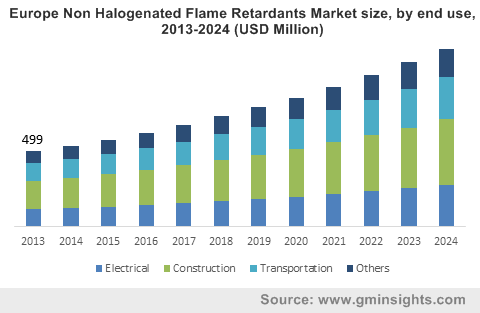Non-halogenated flame retardants market to exceed USD 3 billion by 2024, surging polymer demand from the automotive sector to spur the industry growth
Publisher : Fractovia | Published Date : 2017-06-15Request Sample
Non-halogenated flame retardants market is likely to experience remarkable growth prospects, as per statistics, possibly owing to the extensive usage of the product across the construction and automotive sectors. Polymers are abundantly used in automobiles to reduce the overall weight of the vehicle. In addition, they also help enhance the vehicle’s efficiency. However, it is common knowledge that a polymer component is likely to catch fire subject to excessive heating. In order to avoid such fatalities, it is recommended that non-halogenated flame retardants be used in automotive parts, thereby stimulating the business trends. Growing awareness among the consumers across the globe about toxicity will also positively influence Non-halogenated flame retardants industry size. According to Global Market Insights, Inc., “Worldwide Non-halogenated flame retardants market, having had a revenue of USD 1 billion in 2015, will generate considerable revenue by 2024, with an annual growth rate of more than 8% over 2016-2024.”
Europe Non Halogenated Flame Retardants Market size, by end use, 2013-2024 (USD Million)

Of late, emerging economies such as India and China have been witnessing escalating infrastructure developments. In fact, China has reportedly invested more than USD 1 trillion in construction activities. Non-halogenated flame retardants market from the construction sector will surpass a revenue collection of USD 1 billion by 2024. The growth can be attributed to the surging demand for fire safety material across this sector. The product is mainly used to manufacture various parts useful in infrastructure developments such as wires, cables, switchboards, and building materials. In addition to this, implementation of stringent norms regarding the deployment of fire safety instruments in the residential, industrial, and commercial buildings will also influence non-halogenated flame retardants industry share notably.
Speaking about the regional landscape, Asia Pacific non-halogenated flame retardants market is slated to collect a revenue of more than USD 800 million by 2024. Rapid development across the construction sector will augment the regional growth. Moreover, the availability of extensive manufacturing facilities, coupled with the deployment of fire safety rules and regulations will propel the product demand across this region. China covered more than 40% of the share in 2015 and is expected to contribute remarkably toward the growth of APAC non-halogenated flame retardants market over 2016-2024.
Stringent regulations enforced by governmental bodies regarding the use of toxic material for fire safety products across the globe will be a notable factor fueling non-halogenated flame retardants industry share. The EPA (Environment Protection Agency) has also been promoting bio-based products to reduce the usage of hazardous chlorinated & brominated fire suppressors. On these grounds, North America non-halogenated flame retardants industry had collected considerable revenue in 2015 and will exhibit significant annual growth rate over the years ahead.
Organics phosphorus based products have superior smoke suppressant capability, pertaining to which phosphorus non-halogenated flame retardants market will register a CAGR of more than 8% over the coming seven years. Considering the stringent norms implemented by regulatory bodies to reduce the toxicity level, industry giants are investing heavily to develop non-toxic and eco-friendly products. These efforts are certain to attract more consumers and expand the customer pool of major corporations. The noteworthy participants in non-halogenated flame retardants market are Albemarle Corporation, BASF, Nabaltec, Clariant, Israel Chemicals, Italmatch Chemicals, DuPont, DSM, FRX Polymers, Chemtura, and Huber.
Aluminum hydroxide based products offers superior resistance to smoke. In addition, this product is available at affordable costs, thereby enhancing its demand and leading aluminum hydroxide non-halogenated flame retardants market to record notable annual growth rate over 2016-2024, having had a revenue of USD 300 million in 2015. Aluminum hydroxide based products are mainly used in polymers, FRPs, and rubber. Nowadays, most of the automotive manufacturers are giving preference to polymers instead of metal based products to minimize the weight of the vehicle. This product offers excellent insulation, durability, low heat & smoke emission, and protection, which will fuel its demand in automotive applications. Non-halogenated flame retardants industry from the automotive sector is thus, forecast to exhibit significant CAGR over the years ahead.
Keeping in line with the latest industry trends, market players have been striving to develop eco-friendly products. Their consistent efforts to develop bio-based, cost-effective products will lead non-halogenated flame retardants market to earn considerable revenue over the coming years.